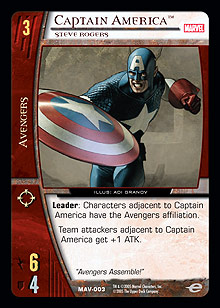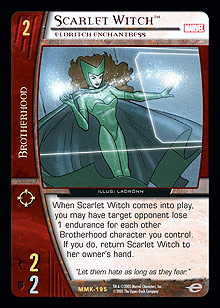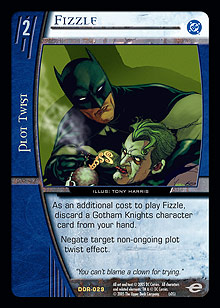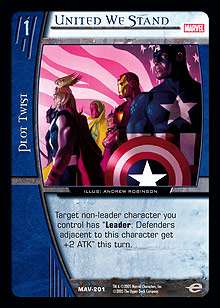
With previews for the Justice League of America set starting tomorrow, I want to tie up some Avengers loose ends before the JLA avalanche begins. As always, once a new card is officially previewed on any site, it becomes fair game for Cerebro questions, so please send them in!
In every column, I give away three boosters to the writer of the most interesting question. To be eligible, please include your name, mailing address, and UDE number. It’s that simple. Here’s this week’s winner:
I was playing a Vs. System draft last week with my guild, and we came across an issue that we definitely need answered. I control Hawkeye, Clinton Barton adjacent to Captain America, Steve Rogers and propose a team attack into my opponent’s Kang, Lord Kang. In response, my opponent plays the ridiculous Spheres of Solitude targeting Hawkeye. Obviously my question is: Does Cap continue to give Hawkeye the Avengers affiliation? If not, what if I move Cap away and then back next to Hawkeye using something like Justice for All? Thank you if you know.
Gary W., Sydney, Australia
 To answer your first question, we quickly have to check the two modifiers applying to Hawkeye after Spheres resolves. Does Cap depend on Spheres? No, because Spheres can’t change what objects Cap’s modifier can apply to (in other words, it can’t change whether or not a character is adjacent to Cap). Similarly, Cap can’t change whether or not an object has been chosen by Spheres, so Spheres doesn’t depend on Cap.
To answer your first question, we quickly have to check the two modifiers applying to Hawkeye after Spheres resolves. Does Cap depend on Spheres? No, because Spheres can’t change what objects Cap’s modifier can apply to (in other words, it can’t change whether or not a character is adjacent to Cap). Similarly, Cap can’t change whether or not an object has been chosen by Spheres, so Spheres doesn’t depend on Cap.
If neither modifier depends on the other, they are simply applied in timestamp order. So, Cap applies first, then Spheres, leaving Hawkeye unaffiliated and causing the proposed team attack to fail the legality check.
The same applies even if you move Cap away and then back next to Hawkeye, because doing so does not change Cap’s timestamp. His timestamp is when he came into play or when he last recovered, not when he last moved adjacent to a character.
However, say Cap becomes stunned later that turn and then recovers. In that case, the same team attack will be successful next turn because Cap’s timestamp is now later than Spheres’. Spheres will apply first, making Hawkeye unaffiliated, then Cap, giving him the Avengers affiliation.
I recently played Squadron Supreme against a Gotham Knights deck. My opponent controlled three characters: Batman, The Dark Knight; Superman, Big Blue Boy Scout; and Huntress, Helena Rosa Bertinelli. Arcanna managed to stun Batman and create her breakthrough replacement modifier. My opponent chose to stun Superman (who was ready and therefore could not be stunned). I suggested that since he had another character who could be stunned (Huntress), he was obligated to stun her. But he said he got to pick the target and that Superman was valid even though he could not be stunned. Is that correct?
Greg L., Covington, KY, USA
 Arcanna’s replacement modifier doesn’t target, but otherwise, your opponent is correct. If Arcanna would cause breakthrough while attacking a character your opponent controls, your opponent must instead choose another non-stunned character he controls and stun it. He need not choose a stunnable character, just a non-stunned one. If he chooses an unstunnable character, the modifier will do nothing.
Arcanna’s replacement modifier doesn’t target, but otherwise, your opponent is correct. If Arcanna would cause breakthrough while attacking a character your opponent controls, your opponent must instead choose another non-stunned character he controls and stun it. He need not choose a stunnable character, just a non-stunned one. If he chooses an unstunnable character, the modifier will do nothing.
A similar example arises between Apokoliptian Hospitality and Dr. Ub’X. Apokoliptian Hospitality reads, “Target stunned character an opponent controls cannot be recovered or KO’d this turn,” and Dr. Ub’X reads, “At the start of the recovery phase, each of your opponents KO’s a stunned character he controls.”
If you control a face-up Dr. Ub’X at the start of the recovery phase, your opponent can choose a character that has been targeted by Apokoliptian Hospitality this turn (and fail to KO it), even if he controls another character that can be KO’d.
My opponent controls Total Anarchy and stuns my Wolverine, Logan. If I respond to the Total Anarchy effect with Children of the Atom, will Wolverine still be KO’d? (I believe so, but I want to be sure.)
Fabiano de C.
Yep, Total Anarchy’s triggered effect KO’s Wolverine whether or not he’s still stunned.
My opponent attacks my Wolverine, Logan with his Thing, Heavy Hitter while I control Sinestro, Green Lantern of Korugar. If I use a Nasty Surprise to stun Thing in the attack, will my opponent lose another 5 points of endurance when Thing gets stunned again by Sinestro’s power?
Fabiano de C.
No, because Thing only becomes stunned once. Your opponent loses 5 endurance during attack conclusion. After the attack, Sinestro’s effect does indeed “try” to stun Thing again, but because he is already stunned, your opponent does not lose another 5 endurance.
 I play Scarlet Witch, Eldritch Enchantress while I control ; Destiny, Irene Adler; and Lorelei, Savage Land Mutate. In response to Scarlet Witch’s come-into-play effect, my opponent plays Flame Trap. I believe he will lose 3 endurance, but will Scarlet Witch return to my hand?
I play Scarlet Witch, Eldritch Enchantress while I control ; Destiny, Irene Adler; and Lorelei, Savage Land Mutate. In response to Scarlet Witch’s come-into-play effect, my opponent plays Flame Trap. I believe he will lose 3 endurance, but will Scarlet Witch return to my hand?
Fabiano de C.
Flame Trap resolves first, stunning all four of your characters.
Scarlet Witch’s triggered effect resolves next, and you may choose to have your opponent lose 3 endurance since you control three other Brotherhood characters (even though they are stunned). If you do, you must still return Scarlet Witch to your hand (even though she is also stunned).
Is a stunned character also exhausted? For example, one of Insect Swarm’s modes targets an exhausted character and returns it to hand. Can I return a stunned character? My friend says I can because a stunned character is also exhausted.
João B., Portugal
Your friend is right. A stunned character is always exhausted, so Insect Swarm can target a stunned character.
Another useful example is Qwardian Pincer, which reads, “Target attacker you control gets +1 ATK this attack for each exhausted character with cost 2 or more you control.” You count stunned characters (with cost 2 or more you control) as well as face-up exhausted characters when calculating the ATK bonus.
I’m playing with a Marvel Knights/Gotham Knights/ New Gods deck against a Gotham Knights deck. On the third turn, I have Fizzle in hand, a face-up Midnight Sons (naming GK), and a face-down The Source, and I place a face-down Midnight Sons. I Wild Ride from hand and my opponent plays Fizzle from his resource row to negate the Wild Ride before passing priority. Can I reveal the Midnight Sons to team up New Gods (it doesn’t go on the chain because it’s an ongoing plot twist), reveal and replace The Source (this one does go on the chain) to remove the Fizzle in my opponent’s resource row (and the two others in his hand), and only then Fizzle his Fizzle?
João B., Portugal
Yep, most of that sounds fine. Let’s step through the action.
 Assuming you control a Marvel Knights character, you can play Midnight Sons from your resource row, but note that its “choose an affiliation” effect does go on the chain. It’s true that the ongoing part doesn’t use the chain, but that part doesn’t do anything useful until the “choose an affiliation” effect resolves.
Assuming you control a Marvel Knights character, you can play Midnight Sons from your resource row, but note that its “choose an affiliation” effect does go on the chain. It’s true that the ongoing part doesn’t use the chain, but that part doesn’t do anything useful until the “choose an affiliation” effect resolves.
After that effect resolves and you choose New Gods, you may replace The Source to target your opponent’s Fizzle. When The Source’s effect resolves, the target gets replaced, and then all of your opponent’s Fizzles get removed from the game.
Finally, you may target your opponent’s Fizzle effect (which is still on the chain) with your own Fizzle.
If my opponent were to play Ka-Boom! on my location, and I responded by playing The Source on that Ka-Boom!, then would the effect be negated and my location stay in play while my opponent loses all of his Ka-Booms?
Duncan T.
Again, that’s largely correct. Let’s resolve the effects one by one.
The Source’s effect resolves first, replacing Ka-Boom! and allowing you to search your opponent’s deck, hand, and KO’d pile for any other Ka-Booms and remove them from the game.
The Ka-Boom! effect resolves next. Technically, it’s not negated because its target location is still legal, but it essentially does nothing because it fails the condition “if Ka-Boom! is in your resource row.” Since Ka-Boom! is no longer in your resource row, everything after that condition doesn’t happen. So, your location stays in play.
Can Unfair Advantage be used to pay the cost of a location card’s effect (such as Midtown High School or Lions Den)?
Al B., Southfield, MI, USA
Unfair Advantage reads, “Spend this resource point only to pay the cost of a payment power.” So, you certainly can spend that resource point to pay the cost of a location payment power (like Lion’s Den’s). You can identify payment powers by the arrow separating cost and effect.
Midtown High School, however, doesn’t have any payment powers. It has only a triggered power (identified by the words “when,” “whenever,” or “at the start”). As a result, you can’t spend your Unfair Advantage resource point at Midtown High School.
If I play United We Stand on a non-leader character, it becomes a leader. If I then use Swift Escape, can I discard that character to pay Hulk, Gamma Rage’s cost?
Michael F.
 Interesting idea, but the United We Stand modifier “loses track” of the character when it changes zones. After it returns to your hand, it’s no longer a leader card, so it cannot be discarded to Hulk.
Interesting idea, but the United We Stand modifier “loses track” of the character when it changes zones. After it returns to your hand, it’s no longer a leader card, so it cannot be discarded to Hulk.
Recently, there has been some debate in my gaming circle about Repulsor Ray and effects like it. It came up when I attacked Human Torch, Hotshot with an Avengers character. My opponent activated Torch’s power, and in response, I played Repulsor Ray. To the best of my knowledge, the chain resolves backwards, so the Repulsor Ray prevents Torch’s power . . . right?
Daniel C., Carmel, Indiana, USA
You’re correct in that the chain resolves backwards, but Repulsor Ray reads, “If that attacker has the Avengers affiliation, your opponents cannot use character payment powers this turn.” When that effect resolves, it stops your opponents from using character payment powers this turn. However, in your question, your opponent used Torch’s power beforeRepulsor Ray resolved, and Repulsor Ray has no impact on Torch’s effect once it’s on the chain.
I need a rules clarification for Yancy Street. With all the KO effects being run these days (Hounds of Ahab, Finishing Move, Quick Kill, and so forth), it seems like a good idea. My question is, can I flip Yancy Street in response to my opponent exhausting a character for Finishing Move? I thought that it would negate the effect, as it would have no valid target, but my friends say the target is declared when the Finishing Move is played, so Yancy Street does nothing.
Ben B.
You are one hundred percent correct and your friends are only fifty percent correct. Your opponent does choose the target when he plays Finishing Move, but a targeted effect always rechecks target legality on resolution.
Yancy Street reads, “Stunned characters you control cannot be the target of effects your opponents control.” So, if you flip it in response, the Finishing Move effect will be negated after successive passes because all its targets are no longer legal.
That’s all until next week, when I’ll have a “super” plot twist to preview for you! In the meantime, please keep your rules questions coming in to vsrules@gmail.com.